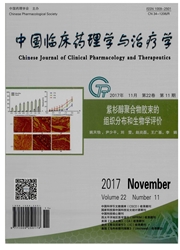

 中文摘要:
中文摘要:
目的:观察紫菀、款冬花部位配伍后的抗炎作用,探讨两部位配伍关系。方法:通过小鼠毛细血管通透性实验、氨水致小鼠急性气道炎症模型及脂多糖(LPS)刺激巨噬细胞释放NO的变化来观察药物的抗炎作用。结果:RA2部位、FF3部位及其配伍均能抑制小鼠毛细血管通透性(抑制率分别为45.1%、45.3%、51.8%)和氨水致敏引起的急性气道炎症(抑制率分别为48.0%、53.4%、61.4%),配伍组作用更强;RA2部位和FF3部位中、高剂量组抑制LPS刺激巨噬细胞后NO的产生(P〈0.05),配伍后作用增强(P〈0.01)。结论:紫菀、款冬花部位配伍后显著提高抗炎效果,符合相须、相使配伍理论。
 英文摘要:
英文摘要:
AIM: To investigate the anti-inflammatory effects of the mixture of the active parts of Radix Asteris (RA) and Flos Farfarae (FF) ( 1: 1, w/w ) and analyze the relation of compatibility between them. METHODS: The anti-inflammatory effects were measured by inhibiting the nitric oxide synthesis in LPS-activated macrophageshe, inhibitioning of capillary permeability in mice and acute airway inflammation caused by centrated ammonia method in mice. RESULTS: Compared with two individual active parts, the mixture playded a more prominent role in inhibition of capillary permeability in mice ( inhibition ratio: 45.1%, 45.3 %, 51.8% ) and acute airway inflammation caused by centrated ammonia method in mice (inhibition ratio: 48.0 %, 53.4 %, 61.4 % ) ; furthermore, the same result resided in RA2, FF3 and their mixture in inhibition of nitric oxide synthesis in LPS-activated macrophageshe(P 〈 0.05 or P 〈 0.01). CONCLUSION: The mixture of two active parts of RA and FF can significantly strengthen the anti-inflammatory effect of two individual active parts, indicating that the mixture of two active parts is provided with mutual promotion effect.
 同期刊论文项目
同期刊论文项目
 同项目期刊论文
同项目期刊论文
 期刊信息
期刊信息
